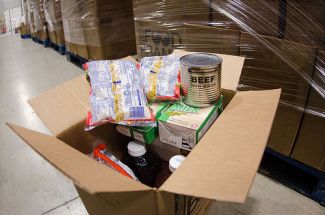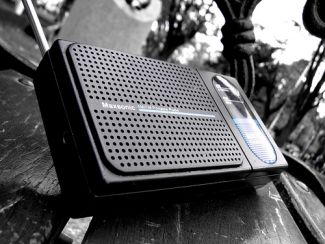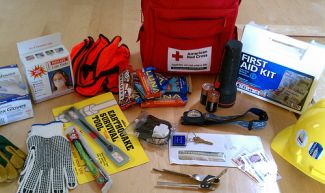How to Make a Home Emergency Kit
Although we hope you never need it, it is important to spend the time to make a home emergency kit. If a sudden disaster, like a hurricane, flood, or long term power outage, strikes, your everyday lifestyle could be turned upside down. It does not take long to craft a plan for emergency situations, and gathering necessary supplies is actually fairly easy to do (it becomes hard, though, once the crisis hits!).
In general, FEMA (Federal Emergency Management Agency) recommends being ready for emergencies in these basic areas: water, food, first aid supplies, sanitation / clothing / bedding, tools, and special items.
Water – Have a 3 to 7 day supply on hand. Estimate your needs at approximately a gallon per person per day, with half of the water being used for drinking and half for hygiene. You may need water purification tablets as well.

Food – Have at least a 3 day supply of non-perishable, easy to prepare foods. Try avoiding salty foods in order to limit thirst. Freeze-dried food like dried fruits, granola bars, beef jerky, or non-perishable high energy foods work well. Canned items like condensed meats and soups, canned fruits and vegetables, and fruit juices are also good choices. Make sure you have a hand can opener to access them. Also, items like peanut butter and jelly, hard candy, canned nuts, and vitamins are good to have on hand, and can be comforting during disasters. Of course, periodically check to make sure that your supply's expiration dates have not passed.
Regarding food choices, FEMA suggests (PDF), “As you stock food, take into account your family’s unique needs and tastes. Familiar foods are important. They lift morale and give a feeling of security in times of stress. Try to include foods they will enjoy and that are also high in calories and nutrition. Foods that do not require refrigeration, water, special preparation or cooking are best.”
Red Cross advises, that individuals with special diets will need particular attention, as will babies, toddlers, and the elderly. (Baby supplies could include bottles, formula, baby food and diapers.) Canned dietetic foods may be helpful for ill or elderly people.
Kitchen supplies to have on hand, besides a manual can opener, include: aluminum foil, utensils for eating and cooking, disposable plates and bowls, re-sealable plastic bags, household bleach, paper towels, and garbage bags for trash storage.
 First Aid Kit – To treat cuts and prevent infections, have peroxide or antibiotic cream available. Also, include bandages of various sizes and gauze, with medical tape for fastening. Other necessities include tweezers, gloves, burn ointment, scissors, a first aid manual, and pain relievers. Dust masks are a good idea as well, since you may have to protect yourself from dust or debris in the air. Finally, moistened towelettes are always helpful to have on hand to make it easier to stay clean.
First Aid Kit – To treat cuts and prevent infections, have peroxide or antibiotic cream available. Also, include bandages of various sizes and gauze, with medical tape for fastening. Other necessities include tweezers, gloves, burn ointment, scissors, a first aid manual, and pain relievers. Dust masks are a good idea as well, since you may have to protect yourself from dust or debris in the air. Finally, moistened towelettes are always helpful to have on hand to make it easier to stay clean.
Medications - Have a 7 day supply of essential medicine that your family needs, along with backups of necessities like eye glasses, contact lenses with cleaning solution, or hearing aids with extra batteries.
Sanitation / Clothing / Bedding – Basics to have on hand include: toilet paper, paper towels, hand sanitizer, moist towelettes (also mentioned above), feminine supplies, and any other personal hygiene items you regularly need.
Anticipate your climate requirements, and have the following for each person: blankets or sleeping bags, a complete change of extra clothing, a hat, and sturdy shoes. Rain gear, insect repellant, and sun screen are also beneficial to pack.
 Tools and Equipment – It is a good idea to have a battery powered or hand crank radio in your kit. You should also have a NOAA Weather Radio with a tone alert. Of course, keep a supply of extra batteries for both. Actually, it is best to have a model that has both battery and solar power supply options. Some models can even be used to charge cell phones when the power is off.
Tools and Equipment – It is a good idea to have a battery powered or hand crank radio in your kit. You should also have a NOAA Weather Radio with a tone alert. Of course, keep a supply of extra batteries for both. Actually, it is best to have a model that has both battery and solar power supply options. Some models can even be used to charge cell phones when the power is off.
Flashlights and extra batteries are a fundamental requirement for your supply kit. Lights are comforting as well as vital for safety. It is best to avoid candles or open flames, which could prove dangerous if unknown flammable leaks are present on your property. A wrench or pliers are also helpful, since you may have to turn off your utilities. Always useful in everyday life, duct tape is a must during an emergency. Also, have a roll of plastic sheeting, which can be used to construct an instant temporary shelter or seal window openings.
Matches in a water-proof container are worth having on hand, especially if you have a fireplace or wood stove that you can operate safely. Make sure you have a supply of firewood as well.
Paracord and carabiners have a huge variety of uses in survival situations, including making tourniquets, splints, and temporary shelters, as well as hoisting and securing objects on the fly. Keep well-made versions of both in your survival kit, along with a book on survival techniques, like the SAS Survival Handbook.
Specialty Items –Keep copies of personal documents (medication lists, medical information, deed or lease to home, birth certificates, insurance policies), photocopies of identification and credit cards, bank and investment account information, family photos, passports, and contact information for friends, relatives, doctors, and emergency numbers. All of this information should be in a water-proof, portable container.
You may need the following miscellaneous items:
- Cell phone and chargers. Have a solar power source if possible.
- Whistle to signal for help.
- Extra car and house keys.
- Extra cash.
- Pet needs - food, medicine, and extra water.
- Entertainment items like books, games, puzzles, paper, and pens.
- Camera so you can document damage to your property.
- Map of your area.
- Full tank of gas in your vehicle.
 Resource Websites: Many of these suggestions came from the sources below, which contain a wealth of advice on specific emergency situations and items to include in your home survival kit.
Resource Websites: Many of these suggestions came from the sources below, which contain a wealth of advice on specific emergency situations and items to include in your home survival kit.
Tel: 1-866-GET-INFO will also access the American Red Cross’ “Be Red Cross Ready” checklists. They are very helpful and free.
FEMA – The Federal Emergency Management Agency, offers a helpful list on its website, called “Recommended Items to Include in a Basic Emergency Kit.”
Individual states and local communities often have their own dedicated websites on this topic, with specifics on local climates, challenges, and needs.
Whether you have experienced serious emergencies in the past or have been fortunate enough to avoid this type of situation, it is important to be prepared for such an event in the future. These situations can be exceedingly stressful and can change people’s lives, long after the event. It is absolutely worth taking an hour or two during your free time to put together an emergency supply kit.
Image sources: US Department of Agriculture, honan, santiagonicolau, and globalx
 The How to Make a Home Emergency Kit by Water Damage Defense, is licensed under a Creative Commons Attribution-ShareAlike 3.0 Unported License.
The How to Make a Home Emergency Kit by Water Damage Defense, is licensed under a Creative Commons Attribution-ShareAlike 3.0 Unported License.
